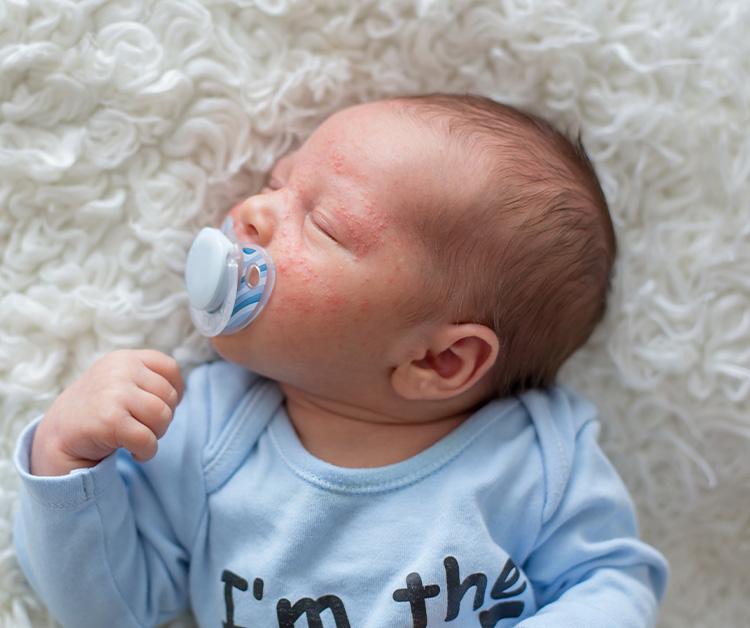Due to maintenance, rewards points for receipt uploads will be delayed. Thank you for your patience!

Learn what baby acne is, how to identify it, and why it’s not worth stressing about. This skin condition is common, painless and temporary, although the symptoms could be signs of more serious conditions that your pediatrician can confirm.
As a parent, the only thing you may feel more than joy and love for your newborn is concern for their health and safety. Even the tiniest blemish or faintest cough keeps most of us—especially new parents—on our toes and up at night. So, when you see small red or pink bumps on your baby’s face or body, it’s only natural to sound the alarms and race to your phone to find answers. As you’ll be happy to discover, baby acne is common, doesn’t create discomfort and goes away soon enough. Ready for the details? Read on.
Baby acne typically presents as red, pink or white raised bumps most commonly on your baby’s cheeks and nose, although it could also appear on the forehead, chin, scalp, chest or back. According to the American Academy of Dermatology Association (AADA), baby acne—also referred to as neonatal acne—occurs in about 20% of newborns at about two weeks of age, but it can also develop at any time prior to six weeks and even at birth.
Acne appearing after six weeks of age is called infantile acne and, while less common than baby acne, is most likely to present between three and six months of age. The AADA considers infantile acne more problematic in terms of scarring and recommends parents seek a board-certified dermatologist or pediatric dermatologist to treat. Infantile acne usually clears in about six months to one year but it could persist in some children for a longer time—even through the teen years.
Baby acne is more common in boys and rarely requires treatment.
MD
Some researchers believe baby acne is caused by hormones passed from a mother to her baby through the placenta, while others theorize it’s an inflammatory reaction to Malassezia, a common type of yeast that can grow on a baby’s skin. Ultimately, there is no consensus on the cause and so the focus for parents and doctors is on proper identification and treatment.
If you notice red bumps on your baby’s face or body after six weeks of age, you may be dealing with a skin infection, eczema, or cow’s milk allergy. Telltale signs of these conditions include inflammation and areas of dry or cracked skin, as well as extreme fussiness, excessive spit-up or even fever. The bumps may itch, ooze, and crust over, or feel like dry, scaly skin.
Rash-like red bumps could also be a reaction to an ointment or oil used in a skincare product you’re using, while white bumps appearing on the forehead, cheeks or near your baby’s mouth are often confused with milia, dead skin cells trapped in small pockets on the skin’s surface. Similar to neonatal acne, milia will typically clear on their own within a matter of weeks.
To be sure, the AADA recommends a skin exam by a board-certified dermatologist and, in certain extreme circumstances, a blood test or x-ray to rule out any serious conditions.
Baby acne typically clears on its own and treatment is more a matter of taking good care of your baby’s skin while they have it. Best practices include washing your baby’s face with lukewarm water and mild baby soap daily, followed by a gentle pat dry. Never pinch or scrub the acne and avoid lotions or oils unless your pediatrician or dermatologist recommends them.
While some natural remedies like coconut oil, dietary changes and breast milk have been reported to help with baby acne inflammation, it goes without saying that it’s essential to consult with your pediatrician before trying any treatment.
Baby acne is common and usually a very temporary skin condition. Developing within the first few weeks after birth, baby acne usually will clear up on its own within three to four months and leave no scarring. If you’re still concerned about your baby’s complexion, consult a pediatrician.
At the end of the day, parenting a newborn is an ongoing learning process where parental instincts, research and professional guidance are all essential to getting through the day and keeping your baby happy and healthy. As we’ve learned, baby acne—and neonatal acne in particular—is on the low end of the parental stress spectrum and can be seen as just another developmental challenge to identify and manage with proper care and attention. And there’s no way to overestimate the dizzying array of challenges we face and meet as moms and dads. There are more common conditions to look for in your little one including cow's milk allergy or gassiness in newborns.
All information on Enfamil, including but not limited to information about health, medical conditions, and nutrition, is intended for your general knowledge and is not a substitute for a healthcare professional's medical identification, advice, or management for specific medical conditions. You should seek medical care and consult your doctor or pediatrician for any specific health or nutrition issues. Never disregard professional medical advice or delay seeking medical treatment, care, or help because of information you have read on Enfamil.